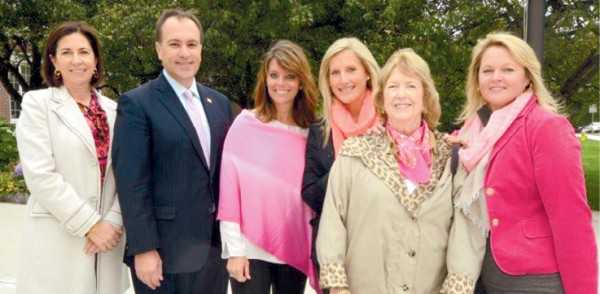October is Breast Cancer Awareness Month is a big one for Greenwich”™s Breast Cancer Alliance, which is celebrating $20 million raised across 20 years for their ongoing fight against the second leading cause of death among women.
The alliance kicked off its pinnacle month with the second annual Go For Pink fundraiser, which drew the support of more than 60 local and national merchants including Vineyard Vines and Saks Fifth Avenue, all of which donated significant percentages of the day”™s profits Oct. 1 to the alliance.
“We were really thrilled and humbled by the support from the community,” Yonni Wattenmaker, executive direct of the alliance, said.
While totals from the Go For Pink event will not be known until later this year, Wattenmaker said a separate funding effort for the alliance”™s premier event, the annual benefit luncheon and fashion show ”” which is among the largest charitable events in the county, drawing more than 900 attendees and donations from well beyond that ”” is poised to raise more than $1 million in advance of the Oct. 22 luncheon.
“Breast Cancer Alliance was founded by six friends who were looking at the disease head-on because one of them was dying from it;Â two have since been diagnosed with breast cancer and survived,” Wattenmaker said. “What started as six women with incredibly wonderful intentions has resulted in an organization that is one of the most prominent nonprofit, non-corporate breast cancer organizations in the country.”
Wattenmaker has been with the foundation for five years. Moving on from a career in education, she was drawn to the alliance from her own experiences with breast cancer, which she said touched the lives of her family and friends.
Her grandfather was a breast cancer survivor and, by the time she turned 40, Wattenmaker said she had friends who had been diagnosed with the disease.
While breast cancer is identified as a women”™s disease ”” affecting 1 in 8 women ”” men are not immune and have an incidence rate of 1 in 100, she said.

- Loren Taufield, Go For Pink Chairwoman, Peter J. Tesei, Town of Greenwich First Selectman, Yonni Wattenmaker, BCA Executive Director, with Emily Klaeboe, Donna Moffle and Trish Kirsch of Greenwich Magazine.
The alliance”™s prominence stems from its dedication to advancing breast cancer research, education and outreach programs as well as funding surgical fellowships.
Wattenmaker is particularly proud of the organization”™s Young Investigator Grants.
“It is like scientific venture capital to launch the careers of these new scientists,” she said.
The grant helps propel young scientists starting out in their careers and includes $125,000 spread across two years for young scientists from Connecticut, New York and New Jersey.
Wattenmaker said, with government funding for scientific research at an all-time low, grants like these have become increasingly important.
But the group”™s efforts do not stop with opening its wallet.
While the alliance has only two full-time employees including Wattenmaker, a legion of health professionals, academics and dedicated volunteers work to direct and track the groups funding projects.
“We really want to see where our money is going; what advances are being made,” she said. “We visit every single person we fund, every hospital, every center for psych/social support and every researcher and we build relationships with them because we believe it is not enough to send a check.”
While proud of the progress made, the fight against cancer persists, especially in Connecticut, which has some of the highest incidence rates of breast cancer in the nation, Wattenmaker said.
With so little known about how cancers are caused, one of the best tools for combating the disease is early prevention education, she said.
“Cancer is just a really insidious disease,” she said. “Education is really critical. Screening and early diagnosis is really critical to survival and there are just a lot of communities throughout this country in which going to doctors or knowing your family history or getting involved with early detection aren”™t things any one really knows anything about.”
Education is particularly important as myths ”” such as breast cancer being mostly hereditary and that mammograms are ineffective or can actually worsen breast cancer ”” persist due to a lack of education.
“Eighty-five to 95 percent of all breast cancer cases are random,” Wattenmaker said, “If you have a family history you are at a higher risk, but that doesn”™t mean you have no risk if you have no family history.”
And according to the National Cancer Institute, “the benefits of mammography nearly always outweigh the potential harm from the radiation exposure.”
While incidence rates of breast cancer among older women have fallen in recent years, the National Breast Cancer Foundation estimates that each year more than 220,000 women in the United States will be diagnosed with breast cancer and more than 40,000 will die.
As the alliance”™s long standing base of support begins to age and retire, Wattenmaker said the organization has made a strategic push to incorporate a younger base of supporters to continue to champion the cause.
“A lot of these younger women have friends who are being diagnosed or they themselves are confronting breast cancer diagnoses and want a place to give back, get involved and make a difference,” she said. “If we are going to have a future as an organization, you need people who are prepared to carry it into the future.”















